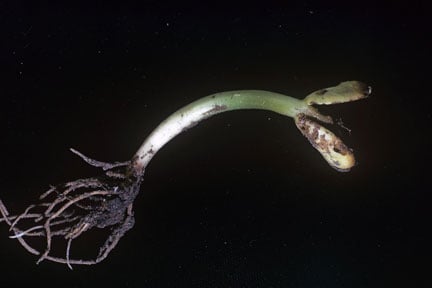
Quick facts
Common name - Bean seed fly
Scientific name - Delia platura and Delia florilega
Plants affected - Seedling French and runner beans
Main symptoms - Seedlings killed or shoots distorted and blind
Caused by - Larvae of a fly
Timing - Spring
What is bean seed fly?
Adult bean seed flies are 6 mm long and resemble small house flies. The larvae are white, legless and headless maggots that reach 8 mm in length. The maggots feed on roots and can kill seedling French and runner beans. Occasionally other vegetables and some ornamentals may be damaged.
The fly belongs to the family Anthomyidae, it is a diverse group of flies with over 100 species Britain. Whilst some feed on roots, others are leaf miners such as the beet leaf miner. Most do not cause damage to garden plants. More information on this fly family is available from the Anthomyidae recording scheme.
Symptoms
French and runner bean seedlings affected by bean seed fly can be killed or emerging shoots are distorted and blind. Seeds sown in cold wet soils often suffer greater losses as germination is delayed and the period over which damage can occur increased. There may be three or four generations of larvae during the summer but most damage is usually confined to the spring, although successional sowings of French and runner beans in particular, can be affected throughout the summer.
Management
- The fly can be largely avoided by raising seedlings in seed trays or pots and planted out once they have germinated
- As the fly only affects young seedlings encouraging rapid healthy growth soon after germination is key to limiting problems caused by this insect
- Adult flies are attracted to soil containing fresh compost, so dig in organic matter the previous autumn where beans are going to be grown
- The soil should be well prepared in order to encourage rapid germination
- Garden-sown beans can be protected by insect barrier netting, horticultural fleece is especially valuable as it provides extra warmth that is highly beneficial to tender crops as well as excluding bean seed fly
- Encourage predators and other natural enemies in the garden such as birds, hedgehogs and ground beetles. Some ground and rove beetles are efficient predators of root feeding maggots
- A mixture of pathogenic nematodes, sold as Fruit and Vegetable Protection, can be watered into the soil which may control the young larvae, this is available by mail order from biological control suppliers. Nematodes should be used in a targeted way as they can also affect non-target species
Download
Biological control suppliers (pdf document)
Biology
There are three to five generations of bean seed fly during the spring and summer but it is the first generation in May, that is often the most damaging.
Adult bean seed flies are 6 mm long and resemble house flies. They become active from May onwards and deposit eggs in the soil. The eggs hatch within a few days. The larvae are white, legless and headless maggots that reach 8 mm long. They feed on the seeds and roots of beans and sometimes other plants such as brassicas, cucurbits, lettuce, onion and sunflower. They can kill young seedlings. The larval stage lasts one to three weeks before they pupate. New adults emerge after three weeks. The flies can overwinter as pupae in the soil, emerging the following year in early spring.





